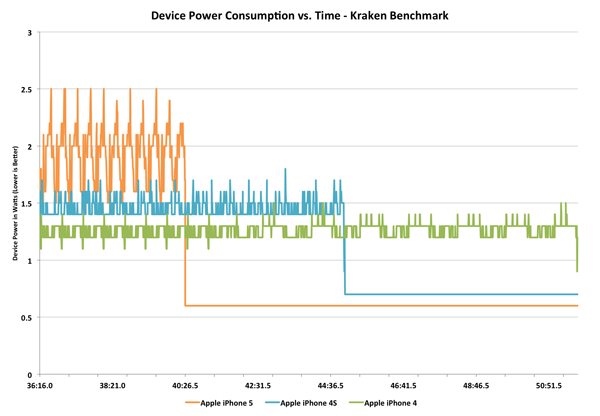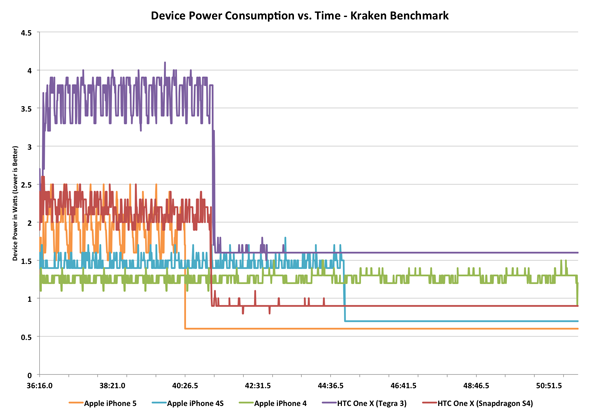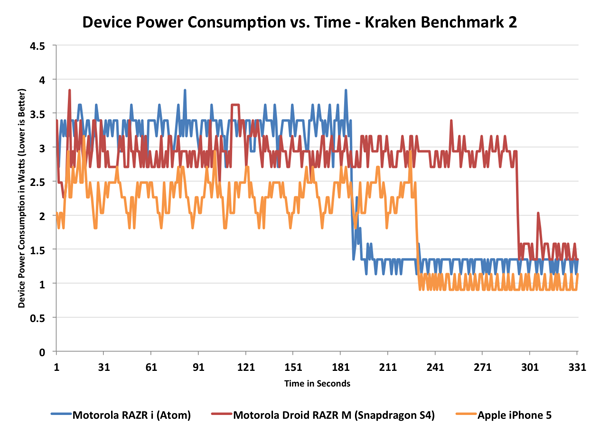The iPhone 5 Review
by Anand Lal Shimpi, Brian Klug & Vivek Gowri on October 16, 2012 11:33 AM EST- Posted in
- Smartphones
- Apple
- Mobile
- iPhone 5
Increased Dynamic Range: Understanding the Power Profile of Modern SoCs
Section by Anand Shimpi
The iPhone 4S greatly complicated the matter of smartphone power consumption. With the A5 SoC Apple introduced a much wider dynamic range of power consumption to the iPhone than we were previously used to. Depending on the workload, the A5 SoC could either use much more power than its predecessor or enjoy decreased overall energy usage. I began our battery life analysis last time with some graphs showing the power savings realized by a more power hungry, faster CPU.
The iPhone 5 doesn't simplify things any more. I believe the days of us having straightforward discussions about better/worse battery life are long gone. We are now firmly in the era of expanded dynamic range when it comes to smartphone power consumption. What do I mean by that? The best way to explain is to look at some data. The graphs below show total device power consumption over time for a handful of devices running the Mozilla Kraken javascript benchmark. Kraken is multithreaded and hits the CPU cores fairly well. The power profile of the benchmark ends up being very similar to loading a very js-heavy web page, although for a longer period of time. All of the device displays were calibrated to 200 nits, although obviously larger displays can consume more power.
Let's start out by just looking at the three most recent iPhone generations:
The timescale for this chart is just how long the iPhone 4 takes to complete the Kraken benchmark. The iPhone 4/4S performance gap feels a lot bigger now going back to the 4 than it did when the 4S launched, but that's how it usually seems to work. Note how tight the swings are between min and max power consumption on the iPhone 4 during the test. As a standalone device you might view the iPhone 4 as being fairly variable when it comes to power consumption but compared to the 4S and 5 it might as well be a straight line.
The 4S complicated things by consuming tangibly more power under load than the 4, but being fast enough to complete tasks in appreciably less time. In the case of this Kraken run, the 4S consumes more power than the 4, however it's able to go to sleep quicker than the 4 and thus draw less power. If we extended the timeline for the iPhone 4 significantly beyond the end of its benchmark run we'd see the 4S eventually come out ahead in battery life as it was able to race to sleep quicker. The reality is that with more performance comes increased device usage - in other words, it's highly unlikely that with a 50% gain in performance users are simply going to continue to use their smartphone the same way as they would a slower device. Usage (and thus workload) doesn't remain constant, it's somewhat related to response time.
The iPhone 5 brings new meaning to device level power consumption. With a larger display and much more powerful CPU, it can easily draw 33% more power than the 4S under load, on average. Note the big swings in power consumption during the test. The A6 SoC appears to be more aggressive in transitioning down to idle states than any previous Apple SoC, which makes sense given how much higher its peak power consumption can be. Looking at total energy consumed however, the iPhone 5 clearly has the ability to be more power efficient on battery. The 5 drops down to iPhone 4 levels of idle power consumption in roughly half the time of the iPhone 4S. Given the same workload that doesn't run indefinitely (or nearly indefinitely), the iPhone 5 will outlast the iPhone 4S on a single charge. Keep the device pegged however and it will die quicker.
Out of curiosity I wanted to toss in a couple of other devices based on NVIDIA and Qualcomm silicon to see how things change. I grabbed both versions of the HTC One X:
The Tegra 3 based One X actually performs very well in this test, but its peak power consumption is significantly worse than everything else. It makes sense given the many ARM Cortex A9 cores built on a 40nm G process running at high clock speeds on the Tegra 3.
The 28nm Snapdragon S4 (dual-core Krait) based One X gives us some very interesting results. Peak power consumption looks identical to the iPhone 5, however Apple is able to go into deeper sleep states than HTC can with its S4 platform. Performance is a little worse here but that could be a combination of SoC and software/browser. I used Chrome for all of the tests so it should be putting Android's best foot forward, but the latest update to Safari in iOS 6 really did boost javascript performance to almost untouchable levels.
At the end of the day, the power profile of the iPhone 5 appears to be very close to that of a modern Snapdragon S4 based Android smartphone. Any battery life gains that Apple sees are strictly as a result of software optimizations that lead to better performance or the ability to push aggressively to lower idle power states (or both). It shouldn't be very surprising that these sound like a lot of the same advantages Apple has when talking about Mac battery life as well. Don't let the CPU cores go to sleep and Apple behaves similarly to other device vendors, but it's really in idle time or periods of lighter usage that Apple is able to make up a lot of ground.
There's one member of the modern mobile SoC market that we haven't looked at thus far: Intel's Medfield. The data below isn't directly comparable to the data above, my measurement methods were a little different but the idea is similar - we're looking at device level power consumption over time while Kraken runs. Here I'm only focusing on the latest and greatest, the Atom based Motorola RAZR i, the Snapdragon S4 based Droid RAZR M and the iPhone 5. The RAZR i/M are nearly identical devices making this the perfect power profile comparison of Atom vs. Snapdragon S4. The RAZR i is also the first Atom Z2460 based part to turbo up to 2.0GHz.
Very interesting. Atom is the only CPU that can complete the Kraken benchmark in less time than Apple's Swift. Peak power consumption is definitely higher than both the Qualcomm and Apple devices, although Intel's philosophy is likely that the added power usage is worth it given the quicker transition to idle. Note that Atom is able to drive to a slightly lower idle level than the Snapdragon S4, although the Swift based iPhone 5 can still go lower.
At least based on this data, it looks like Intel is the closest to offering a real competitor to Apple's own platform from a power efficiency standpoint. We're a couple quarters away from seeing the next generation of mobile SoCs so anything can happen next round, but I can't stress enough that the x86 power myth has been busted at this point.
I will add that despite Intel's performance advantage here, I'm not sure it justifies the additional peak power consumption. The RAZR i ends up being faster than the iPhone 5 but it draws substantially more power in doing so, and the time savings may not necessarily offset that. We'll see what happens when we get to our battery life tests.













276 Comments
View All Comments
rarson - Thursday, October 18, 2012 - link
Me too, other than the stupid proprietary connection that jacks the price of everything up.Spunjji - Friday, October 19, 2012 - link
I sit pretty firmly in this camp, too. Despite the physical durability flaws, I do find the overall package of the iPhone 4/4S/5 to be superior to most comparable 'Droid handset. I just find the software to be unbearably obstructive to my desired use patterns.steven75 - Wednesday, October 17, 2012 - link
Maybe some people want a still larger display but keep the industry leading app support, industry leading hardware ecosystem, airplay, apple store support, industry leading resale value, industry leading OS upgrade support, and without any carrier bloatware?Seems pretty possible to me.
GotThumbs - Tuesday, October 16, 2012 - link
"we've just got to deal with it." Wrong. You have to "deal with it".Believe it or not....everyone does NOT own one of these phones. The idea of getting a brand new item, be it a car, camera, laptop, tablet or phone and having to deal with the fact that that the companies quality controls are sub-standard is one of the lamest things I've heard....Oh! besides the number one example...... "You're holding if wrong" - Steve Jobs.
I try to not let this kind of monologue that reeks of Apple fanism not bother me...but come on! Talk about romancing about a freaking phone. Please keep it to a level of unemotional comparisons and the feel free to give your personal thoughts and not assume to speak for everyone else.
The fact that you felt compelled to write 5 or more paragraphs on the anodizing process is just pathetic. I stopped reading about it after the first paragraph and skipped to the bottom. I thought this is supposed to be a phone review, not a discovery channel episode on the anodizing process. I can't speak for you or anyone else, but I'm pretty comfortable telling you most consumers probably don't care about the process of anodizing, they just expect a quality product for their money.
People are paying good money...in a bad economy and your saying all they can do is "deal with it"? How about having an open mind and mention they have the choice to buy a different phone or wait for Apple to fix it in their next generation. Your only position appears to be....suck it up, its Apple and thats just part of being in the collective.
Again,,,,, YOU do not speak for everyone so please drop the "WE".
Rant done.
Best wishes to all on your choices in life.
crankerchick - Tuesday, October 16, 2012 - link
Talk about overreaction. Keep the statement within the context of the article. iPhone users have to deal with it if they want to remain iPhone users. Anand is an iPhone user as well are more than a few people reading his review--thus the use of the word "we" instead of the use of the term "iPhone users."That said, he should take care lose the "we" but wow, what a rant for something that one can easily use common sense and say, "No I'm not stuck with it." Other bloggers and review sites do the same thing.
LOL, everyone is always looking for someone to point the fanboy finger at.
KPOM - Tuesday, October 16, 2012 - link
Apparently you have never read an AnandTech review. They go into that kind of detail all the time. That's what people like about them. You aren't going to read that in a CNet, The Verge, or Engadget article. You might get some of that at Ars Technica. But AnandTech goes into excruciating detail.VivekGowri - Tuesday, October 16, 2012 - link
I mean, it's not like Apple is going to radically alter it a month after production starts, so if you want an iPhone 5, your options are to either put a case on it, or suck it up and live with the scratches. Alternatively, you could buy a 4S (if you want iOS) or any other phone that floats your boat.I'm a guy that daily drives a Galaxy Nexus, so accusing me of iOS fanboyism isn't necessarily the most productive way of going about your day.
phillyry - Sunday, October 21, 2012 - link
Yes!Well said Vivek.
But ya, Apple should still have the pressure put on them. So, I could see how people might take it the wrong way. 'Cause it could seem like you're just like, "It's all good Apple, we'll just suck it up." When, in actuality, your ideas are as you stated here. As per the OP's rant, I definitely thought it was off-base but could see where he would draw that conclusion, as it came across that way to me too. And, perhaps like me, he has a hard time keeping track of who uses which phone from the podcasts.
Again, well retorted though.
jiffylube1024 - Tuesday, October 16, 2012 - link
You are seriously complaining about the depth the review went into on the anodizingprocess? You're reading a review of a product and you're complaining that you're being given more information? How about you just skip over that section if it doesn't interest you.
I lol'ed that you called that kind of serious scientific investigation into the anodizing process (which I found incredibly informative) "pathetic". Real, fact-based journalism apparently bores you; you'd just rather read opinion pieces and pass judgment on them. How high minded of you!
Other reviews don't even mention anything about the anodizing process other than that it's there. I don't get why you'd even bother reading a review on AnandTECH if you don't care about the technology...
As for the author's position to "deal with it" (the anodization scratch issue) -- what more can the author do? He can't fix the problem or even address it from a manufacturing standpoint. The review points out the issues with it; the decision making process is up to the consumer and the fixing of the problem is up to the manufacturer.
GotThumbs - Wednesday, October 17, 2012 - link
"Other reviews don't even mention anything about the anodizing process other than that it's there. I don't get why you'd even bother reading a review on AnandTECH if you don't care about the technology..."Anodizing a piece of aluminum does not constitute "technology" when compared to the design of a SoC or camera, at least in my opinion. I see it as a finishing process. My point is that a side link to more detailed information on the anodizing process would have sufficed and kept the reader on track with the hardware review.
I visit Anandtech on a daily basis and have been reading/visiting this site from the early years when Anand was still in High School. I thoroughly enjoy reading/learning about how new technologies in hardware are evolving and when they are compared to other current hardware available in the marketplace. But I feel there has been a growing tendency in Apple product reviews to have a hint of personal/emotional input rather than sticking to an analytical/technical assessment and let each reader digest the information without the personal emotional spin. It's like todays "News" casters interjecting thier personal thoughts/opinions on a news story. I prefer to get the facts and come to my own conclusion.
In case you haven't realized, more and more in todays society, we are "Marketed to" in ways that are growing exponentially. Todays marketing companies continue to market to us using methods not just like Product Placement in TV shows, Reality shows, Movies, Red Carpet runways. etc., but on FB, Twitter, blogs, and weak "tech reviews" like CNN's (Read more like product ads than a review) etc. Because of this bombardment of marketing from every possible source imaginable and newly evolving, I don't think its wrong to call out a reviewer when I feel there is even a whiff of non-neutrality. They can take it with a grain of salt or ponder on their next review to be sure they are approaching it in a clear and unbiased manner.
Complacency in a society and lowering on one's expectations is not something to embrace, its to be challenged and called out.
Listen, no one is perfect and yes I may have been a little high strung in my post, but it was fueled by emotion and passion and I won't apologize for that.
I do apologize to Vivek Gowri if I offended him in any way. It was not my intent.
Best wishes